Church of Santa Ana Triana

The Real Iglesia de Santa Ana is a parish in Seville located in the Triana neighborhood, between Vázquez de Leca, Pureza, Bernardo Guerra, and Pelay Correa streets.
Its construction was initiated by King Alfonso X. the Wisein the 13th century, devoted to Saint Anne, after the reconquest of the city. Initially, it was fortified as it was located outside the city walls. This is evidenced by the characteristic battlemented finishes on the rooftops of its terraces.
Was completed in the FOURTEENTH century with the elevation of the tower. Was the subject of reforms in the XV and XVIII centuries.
In 1972, a complete restoration was carried out, during which the Baroque interior decoration was removed.
Exterior of the Church

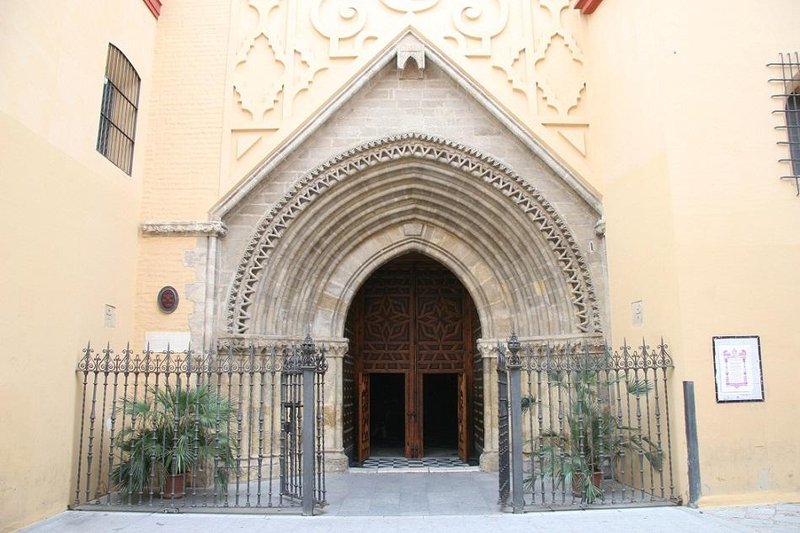
Highlights of the mudejar tower. It was renovated after the earthquake of Lisbon, adopting the appearance baroque presents today.
The church has three doorways carved in stone, protected by grilles, one is located at the foot and two on the sides. The best preserved its original appearance in gothic-mudéjar is the left side, corresponding to the nave of the Gospel, which is made of stone and framed with the coat of arms of Castile. On the wall, the tiles of the Virgin of Carmen and Saint Anne with the Virgin and Child. The front page of the end of the nave is of the neoclassical style, with the tile of the Divine Shepherdess to the left. The nave of the epistle is simple, with pointed arches on pillars of smooth, in it you will find a plate that reminds Vicente Yáñez Pinzón, buried in this parish.

Interior of the Church and Altar
The Church consists of three naves; the central nave is taller and wider than the side ones. The floor is rectangular, without transept and the roof is covered with vaults of gothic carried out in brick, material of the zone. Complete with several chapels, covered vaulted and decorated with murals and wall tile. The temple contains a collection of valuable renaissance paintings of various authors, and a collection of tiling Triana several times.
The main Altarpiece is a work of the SIXTEENTH century, is situated at the end of the central nave. Adapts to the shape of a polygonal apse. It is a magnificent work of art gilded wood. It is composed of three bodies, with seven lanes and attic. It is chaired by the images of Saint Anne with the Virgin and Child, in her dressing room, a work of the second half of the EIGHTEENTH century. On the sides the images of saint Peter, Saint John the Baptist, St. Jude Thaddeus, St. John the Evangelist, Paul and James (XVI century). Is complete in the attic with God the Father and over-the-door access to the interior of the altarpiece, with a relief of the Holy Face, the work of Roque Balduque (XVI century). The altarpiece is complete with the cycle of renaissance paintings of Peter's Campaign: in the center of Saint George, in the high part of the Assumption of the Virgin. On the sides, scenes from the life of santa Ana and san Joaquín (rejected from the temple, leaving his home, the announcement of the archangel and the Mystical embrace of the Golden Gate); also scenes about the life of the Virgin Mary (Birth, Filing, Crowning, Betrothal, Visitation). Finally, it adds the nativity of st. John the Baptist and the birth of Jesus. In the attic, each side of the Assumption, Mary of Cleopas and Mary Salome with their children.
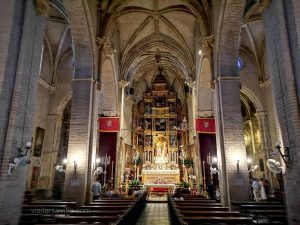

Nave of the Epistle
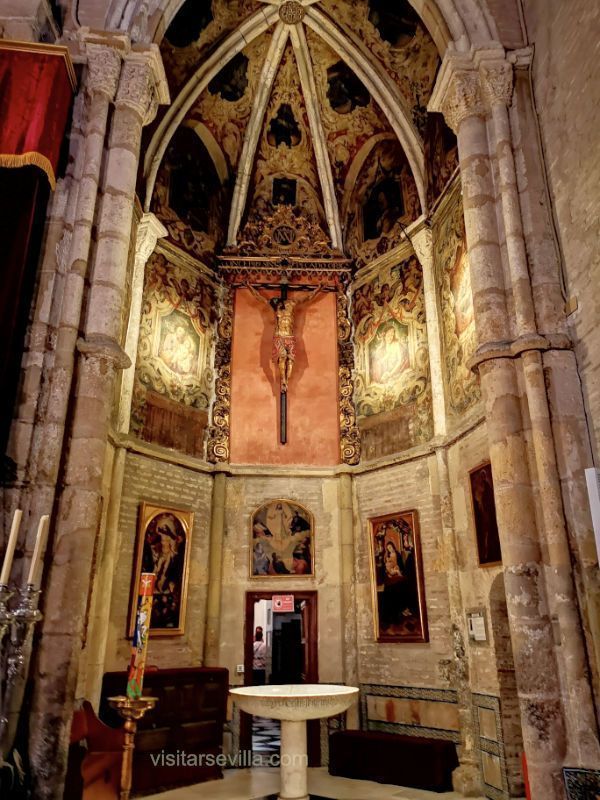
At Calvary chapel. It is located at the head of the right nave, which has an octagonal shape, open, in the gothic style. Presided over by a crucified Christ, the Relief, the work of the SEVENTEENTH and decorated at the top with murals that represent San José, Santa Ana, San Joaquin, and San Juan Bautista, works of Domingo Martinez, EIGHTEENTH century. In the lower part are several paintings of the renaissance period as the Virgin of the Remedies of Juan de Zamora, in the SIXTEENTH century, the Resurrection and Ascension of Christ, and a written framed in the NINETEENTH century, about the construction of this church. Today is the baptismal font, the FIFTEENTH century.
From this chapel is accessed to the Sacristy. At his side, in the wall, the tables renaissance of the master of Moguer, with the Adoration of the Magi and the saints Justa and Rufina.
Access door of the Epistle
Chapel of the Virgen de la Victoria, formerly of Santa Barbara. Dedicated to this seated figure of the old convent of the Minims, a work of the SIXTEENTH century, is closed with a fence, and has a baroque altarpiece and walls of tile in the attic the image of San Francisco Javier.
On August 2, 1519 in front of this image is carried out the rite of the delivery of flags and the taking of the oath of the 234 members of the expedition of five ships, under the command of Fernando de Magallanes, began the first circumnavigation of the Earth.
It was also the first image that fell on the 9th of September 1522, Juan Sebastián Elcano and the other 17 survivors, crewing the nao Victoria, arrived in port. Next to the altarpiece, the image of st. Nicholas Saggio of Longobardi, holy is the least Italian of the SEVENTEENTH century.

Chapel of the Divine Shepherdess
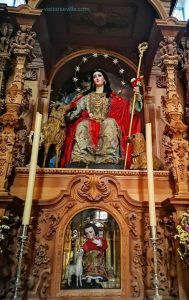
It is closed with grate and has simple décor, highlighting its altar decorated with glazed tiles. The altarpiece, made of wood without paint, it is modern, neo-baroque. Is dedicated to the Virgin of the more romantic style of any procesionan, patron saint of the National Sport, the work of Gabriel Astorga, 1865, coinciding with the foundation of his brotherhood. Under the Virgin, in a display case, the Shepherd Divine.
Importantly, the tiles that adorn the chapel and the moderna picture of saint Angela of the Cross, the owner of their brotherhood, preserving your heirloom that you can kiss the day of his feast day, November 5.
Chapel of las Animas
It is located at the foot of the vessel, decorated with a bow of crest of the SIXTEENTH century, with a relief of the Souls. It is closed by a gate of the SIXTEENTH century, depicted Christ the Judge, and San Miguel. The chapel is dedicated to the Virgin of Carmen, in a baroque altarpiece, the image of the EIGHTEENTH century, coming from the old carmelite convent of the Remedies, which took brotherhood own and today the procesiona the parish from time to time. To their sides the images of the San Gabriel and San Rafael and in the attic a relief of the Souls in purgatory.
The chapel is covered with a dome, being represented San Miguel and in the sockets include tiles of the SIXTEENTH century.
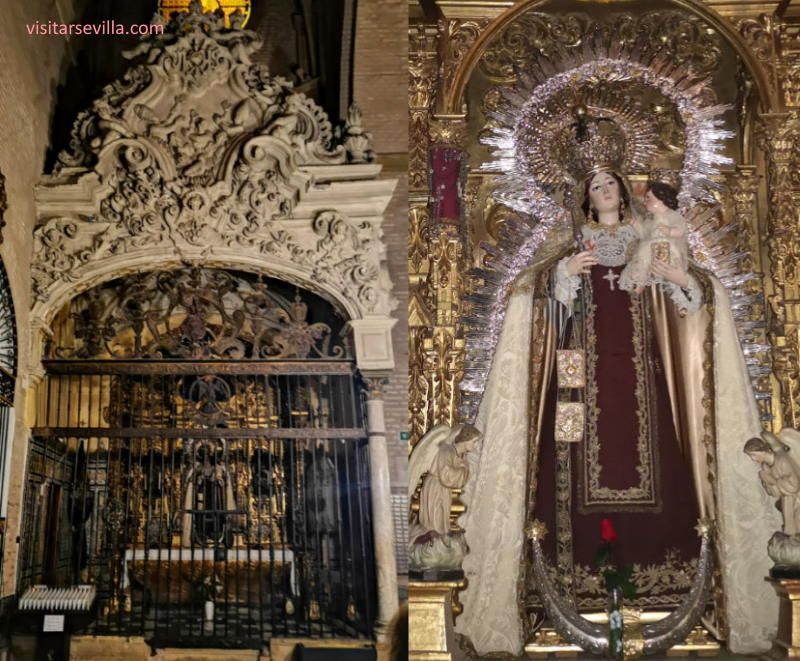
Nave of the Gospel
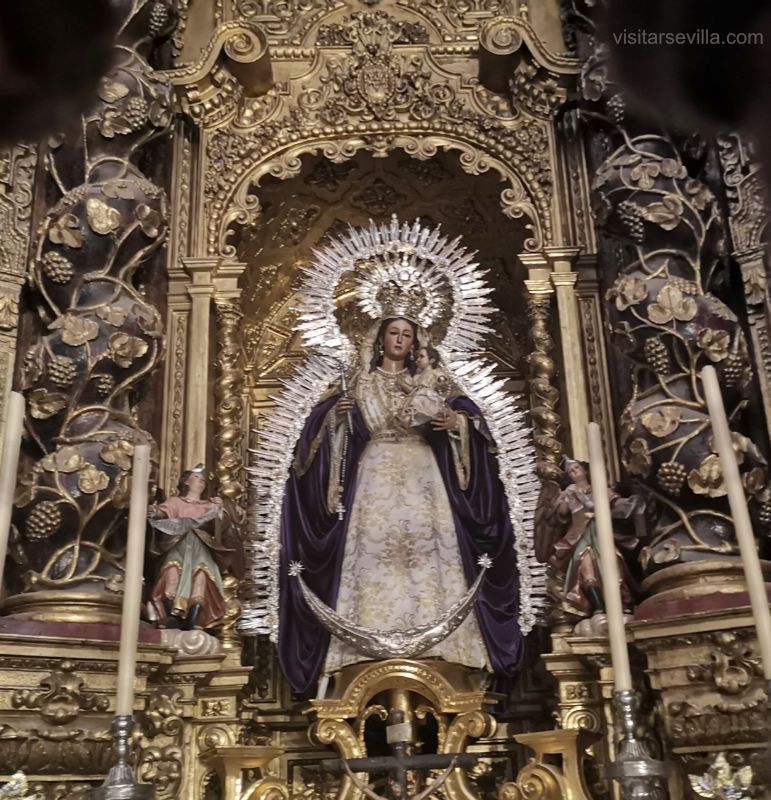
Chapel of the Virgin Mother of God of the Rosary. Located at the head of the ship left. Highlights your fence, the dome of edges and its baroque altarpiece with large spiral columns of the XVIII century. The image of the Virgin is of the NINETEENTH century, attributed to Juan Bautista Petrone, patron saint of foremen and bearers. The accompanying images of san Jose, santa Teresa, san Joaquin and santa Ana. Complete with tiles Manuel Arellano and Mensaque, from the early TWENTIETH century. In the niche is the Monstrance Sacramental of silver, of the EIGHTEENTH century, with three bodies. In the first, the images of Saint Anne, the Virgin and the Child, the second the monstrance, and in the third, the smallest, is represented the Lamb with flag and Cross. At his side is a shelf with the image of st. Michael the Archangel, though these images may vary. On the wall, there is shown a picture of the Virgin of the Rocío.
Sacramental Chapel
In the XVI century. It has decorated gate closed with a grating, in the dome we see frescoes from the Archangels and is presided over by a baroque altarpiece of the EIGHTEENTH century, dedicated to the Immaculate conception.
The Virgin mary is the image of the SEVENTEENTH century, holder of the Sacramental fraternity, procesiona the day of Corpus christi. The accompanying images of san José and san Antonio, in the attic reliefs of the Coronation, Adoration of the Kings, presentation in the temple, and next to the altar, the Sweet Name of Jesus, image of the Child Jesus school of Martínez Montañés, which also procesiona in your step the day of Corpus christi.
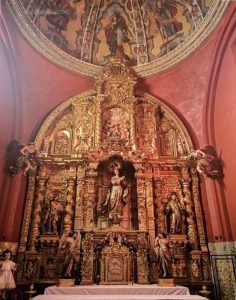
Altarpiece of the saints Justa and Rufina
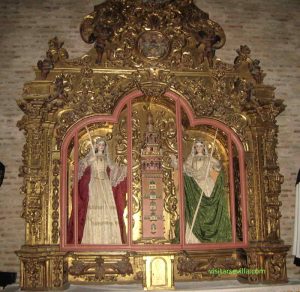
It is located in front of the former chapel and on the side of the choir, images procesionan the day of Corpus christi.
To each side of the holy sevillanas are the pictures of st. Francis of Paula, and saint Teresa of Jesus, from the disappeared convent of the Victory and of the Remedies.
Baptismal Chapel
Of the SEVENTEENTH century, where was found the baptismal font is accessed by gate. Inside, admire the half dome and the walls are beautifully decorated with mural paintings and the paintings of the Baptism of Christ of Thomas Martinez, school of Murillo, the SEVENTEENTH century, and two copies of Rubens, who represents the betrothal of St. Joseph and the Virgin and the presentation of Jesus in the temple. The sockets are made of tiles trianeros.

Chapel of St. Francis of Assisi
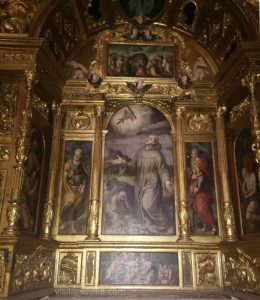
Is at the feet of the spaceship, it has grate and crest, similar to the chapel of the Virgin of las Animas, with a relief of the Transfiguration of San Francisco.
It is presided over by a plateresque altarpiece with renaissance paintings of Pedro Villegas Marmolejo, representing the transfiguration of San Francisco with San Pedro and San Pablo. On the side of the beheading of St. John and St. Jerome penitent.
Santa Ana. Chapel
With two bodies, both of the NINETEENTH century, the Choir is located in the second section of the central nave, decorated with baroque plasterwork of the EIGHTEENTH century, and chairs of the SEVENTEENTH century. It is closed on three sides, leaving open through a gate to the main Chapel.
Chapel. It is of baroque style and is situated in front of the door of the fund of the central nave. In it we highlight the picture of the Virgin of the Rose, a renaissance building of Alejo Fernández, 1535, to the accompanying images of San Felipe Neri and san Juan Nepomuceno.

